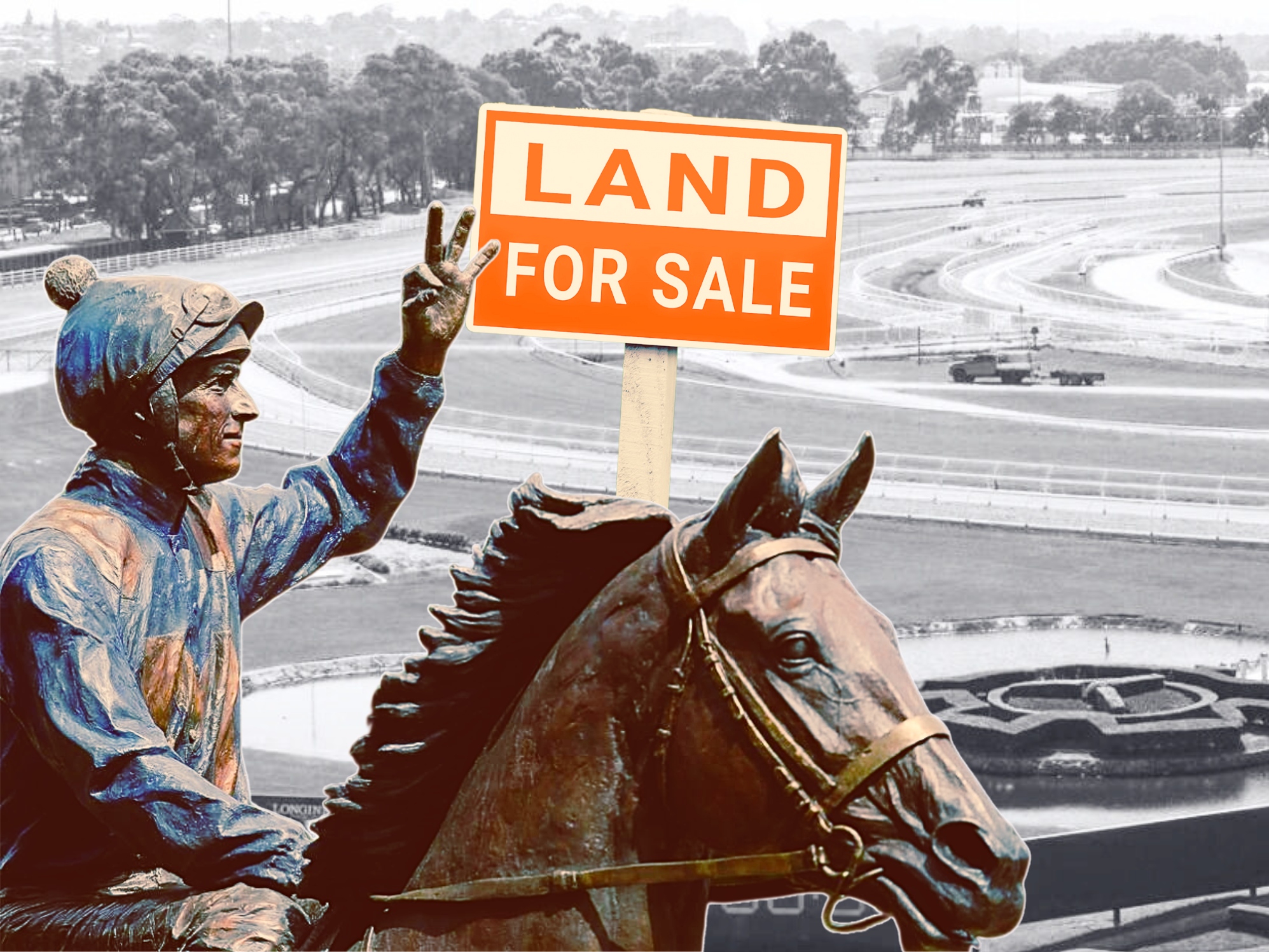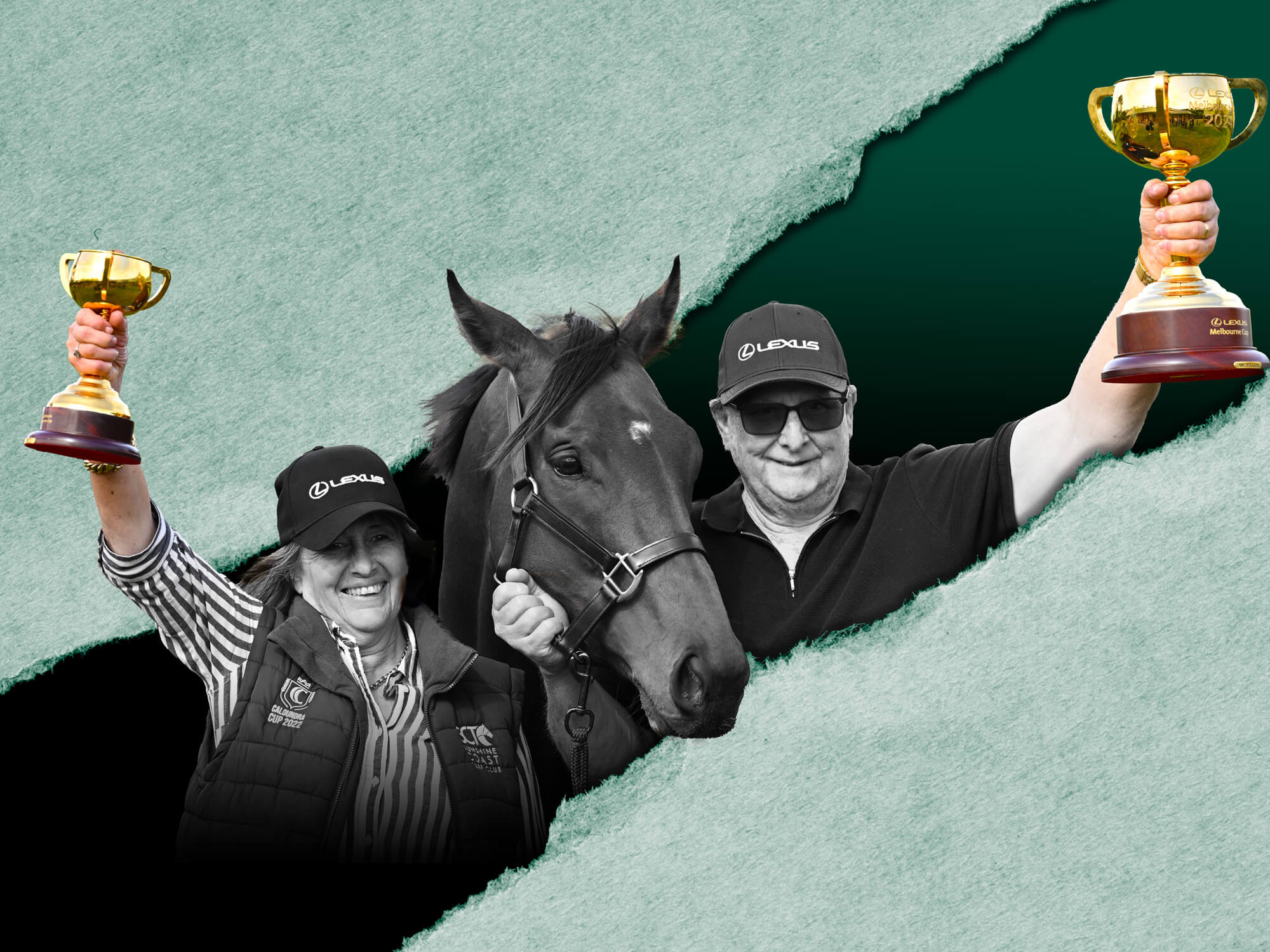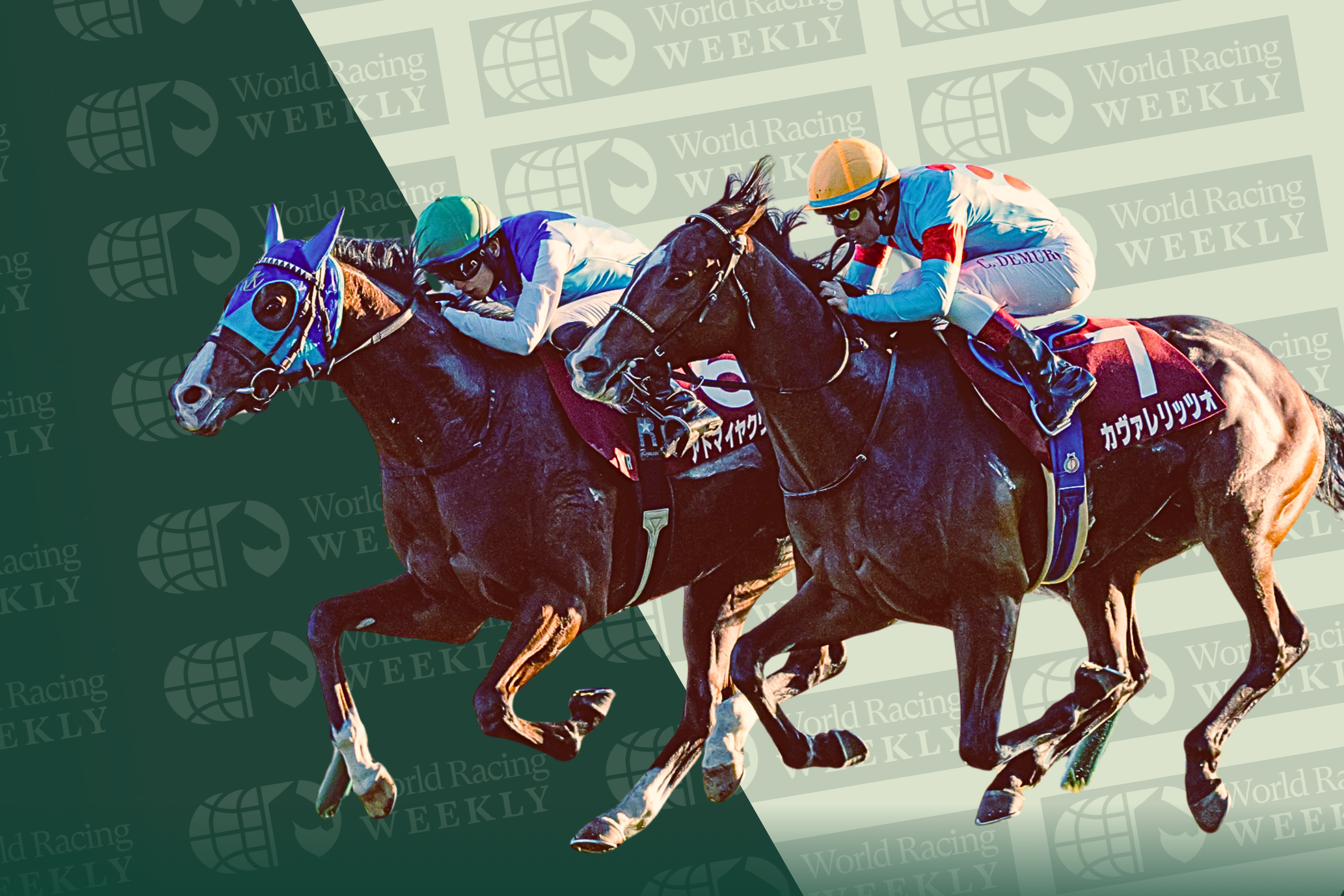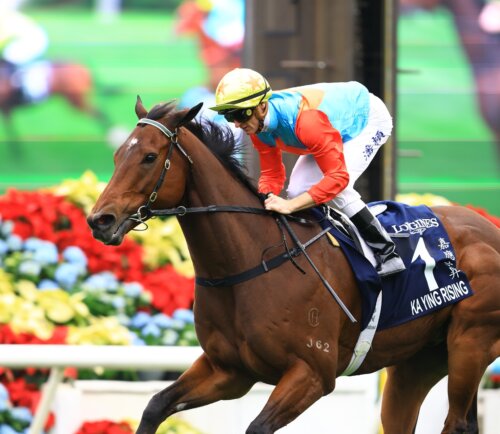The Five Billion Dollar Question That Has Divided Australian Racing
The battle for the future of a western Sydney racecourse has sparked bitter division and power struggles ahead of a vote that some have called the most important in the history of Australian racing, writes Adam Pengilly.
The Five Billion Dollar Question That Has Divided Australian Racing
The battle for the future of a western Sydney racecourse has sparked bitter division and power struggles ahead of a vote that some have called the most important in the history of Australian racing, writes Adam Pengilly.
31 March, 2025THE MOMENT you walk in the main spectator gate, it’s right there. A life-sized re-creation of one of the best jockeys Australia has known, bronzed in a blue hue, his left arm in a signature “she’s apples” pose.
The horse itself is eerily reminiscent of the real one herself, head slightly lifted, eyes strikingly alert, picture perfect. Horse and rider are moving as one, and not moving at all. Some people run past it to take up a position on raceday, the majority walk, others occasionally shuffle, or sometimes just stand and stare.
There might still be minor argument as to whether Winx is the greatest racehorse Australia has ever produced, but there can be no doubting her statue, underneath a replica of jockey Hugh Bowman, is a focal point for anyone who walks into Rosehill Gardens, the track where she was based for her monumental career.
“This monument will stand for the ages as a testament to her legacy as Australia’s greatest ever racehorse,” gushed NSW parliamentarian Kevin Anderson upon its unveiling.
And who was to disbelieve him?
But just four years after the “permanent tribute” to the legendary racehorse was unveiled, if the club who commissioned the work have their way, the entire racetrack on which the 600kg statue stands will be razed for housing – and the statued Winx will need to find a new home.
Next month, the 11,500 members of the Australian Turf Club (ATC) – which race at four tracks across Sydney, with its primary asset the 25 hectare Rosehill Gardens course in the heart of the city’s west – will be simply asked: do you agree to sell the racetrack for $5 billion?
“This is the biggest financial decision made in the history of horse racing,” says Group 1-winning trainer Richard Freedman, who prepares horses out of Rosehill with son Will. “The important thing is we get to the right decision. You have to make the right call here.”
It’s been a little over a year since the NSW government and its premier Chris Minns announced it had signed a memorandum of understanding with the ATC to redevelop Rosehill Gardens for 25,000 homes. The snap announcement, only weeks before Christmas in 2023, was shrouded in secrecy and stunned the horse racing community.
Rosehill Gardens is the financially stricken ATC’s most valuable asset, the home of the Golden Slipper and Australia’s only raceday with five Group 1 events. It’s also minutes from Parramatta’s central business district, now considered the heart of Sydney.
Not only providing a huge windfall for the ATC, the decision was going to be a huge win for the NSW government too, which has come under increasing pressure to alleviate the city’s housing crisis, where the cost of buying property has ballooned in recent years, and rentals are short in supply.
But what has happened since has been bitter and divisive.
High-profile racing figures have fallen out, friendships have been strained, and in some cases ended, the ATC board has splintered, proponents of the sale have tried to torpedo the club’s chairman and the industry even had to embarrassingly air its dirty laundry in a parliamentary inquiry about the bona fides of the Rosehill sell-off proposal, and who knew what and when. Various witnesses told the hearings the valuation of the land could range anywhere from A$1.6 billion to A$23 billion.
The shedding of Rosehill for the racing industry will only proceed if the majority of votes from ATC members agree to the sale (voting is not compulsory). ATC chairman Peter McGauran, who has driven the concept from inception, will accept the final decision, as will the NSW government.
And a fierce campaign from those opposing the sale, led by champion trainer Gai Waterhouse, have worked feverishly in recent months to scupper the proposal.
“They should be ashamed of themselves,” Waterhouse tells Idol Horse. “The members own it.
“Rosehill is a major track in a major densely populated area, it should be there for the community. Why can’t they spend money on it and build around the edge of it and use the centre of the track for sporting facilities like they do in Hong Kong?
“If Rosehill gets sold, you can’t buy that ground again.”
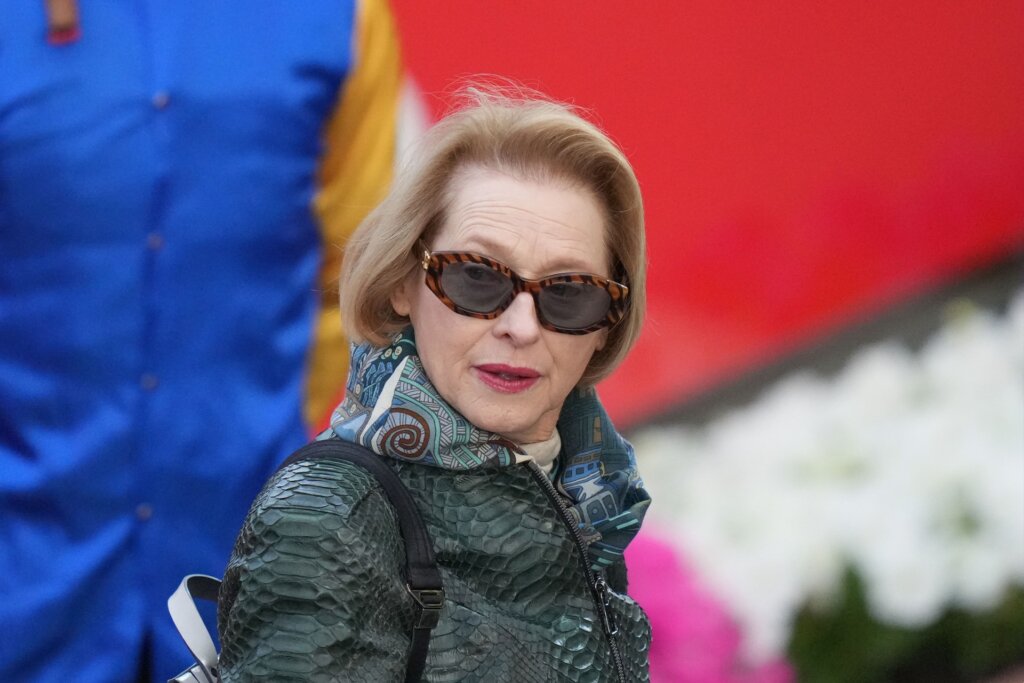
So, why is the ATC even considering the sell-off of its most valuable asset?
McGauran is a former federal government minister in the John Howard era, and is used to his share of brickbats in the public spotlight. But nothing has arguably been as personal as the Rosehill saga.
Unlike the majority of positions on the ATC board, he was an appointee from the government, rather than elected by the members. That doesn’t sit well with many. From the moment he stood shoulder to shoulder with Minns to announce plans to redevelop Rosehill, he’s had a target on his back from angry racing industry figures.
But the government’s appetite for large slices of land for housing or green space is mirrored right across the sporting sector.
The most publicly used golf course in Australia, Moore Park Golf Club, is just minutes from Sydney’s central business district. It’s been in the middle of a tug-of-war after the NSW government announced plans to slice the course in half for more community usage, including junior sporting fields.
Privately, the ATC sees its Rosehill trade-off as a way of future proofing for generations an increasingly marginalised industry, with a plan which also curries favour with governments growing larger in their scepticism of the sport.
But while it might help government relations, the primary reason is simple: money.
“(This vote) is absolutely critical in deciding whether we are a niche sport within 20 years with falling revenue and attendances, or whether we can reinvent ourselves to attract new generations,” McGauran says.
“The decline in wagering in attendances is far steeper and faster than anyone imagined. Wagering’s downturn is 10 per cent year on year and when the federal government brings in its gambling restrictions, it can only accelerate. Our attendances are in freefall.
“We will be entirely in control of our own destiny and future. Much of that will be to rebuild a community licence.
“At the moment young people just see us as a gambling industry with a sport too complicated to understand, and overlaid with horses who are being whipped to finish in front. We can counter all that.
“There are so many opportunities. Racing once had massive attendance and was deeply embedded in the Australian culture. No longer. This is a trend all around the world except for Hong Kong, Japan and Korea. They all own the tote.
“Every other racing jurisdiction is now limited to the carnival days. America is a very telling comparison with Australia. We are successful on five race meetings a year and are playing to empty grandstands for the rest of it.”
Just 12,111 people attended the Golden Slipper meeting in March, and the amount of Rosehill visitors each year has halved in the last decade to the point where less than 100,000 clicks of the turnstile were recorded in 2024.
How the ATC plunged into a financial blackhole is worth investigating.
Its primary revenue stream is from wagering, but tied to a legacy deal which involves distributions from the company’s biggest bookmaker, Tabcorp, and its struggling tote. On top of that, Tabcorp has had to fend off cuts to its market share from Australia’s online bookmakers such as Sportsbet and Ladbrokes, who run aggressive marketing campaigns targeted at a younger demographic.
The state’s regulator, Racing NSW, provided a $9.2 million top-up to the ATC in its last financial year to cover falling gambling returns. Racing NSW has privately supported the Rosehill proposal, but when approached for this story, chief executive Peter V’landys declined to comment.
But V’landys was at his combative best during last year’s parliamentary inquiry, which saw him face off with maverick politician Mark Latham, an ATC member himself who has been a staunch advocate for the racing industry to retain Rosehill.
In an appearance which lasted over an hour, V’landys traded extraordinary barbs with Latham as the inquiry turned the blowtorch on Racing NSW, rather than solely focus on Rosehill. At one stage, V’landys took aim at “wealthy breeders” he said were using the Rosehill saga to get him.
“You continue to try to smear me,” he told Latham. “You’re taking submissions from undesirables and people that are cruel to horses.”
And so it went around in circles as the financial reality of the Rosehill proposal was argued.

Months on, and McGauran argues the ATC subsidises training at its tracks to the tune of $8.7 million per year. It can’t afford to renovate ageing facilities.
The ATC’s members’ pack before the vote said, if successful, it would use $1.9 billion of the $5 billion injection to upgrade and improve Royal Randwick, its primary track leased on crown land, and demolish the dilapidated Warwick Farm and build a Group 1 standard facility from scratch. The works will be bankrolled by the NSW government, with racing to continue at Rosehill until 2031.
It will still have $3 billion left to invest, after further payments from the government before the end of a 15-year period, with a portion of that potentially funding a new track in Sydney to replace Rosehill. The ATC says it is negotiating with two landowners, one on a site to the east of Rosehill and another at Penrith. It won’t disclose their location due to commercial sensitivities.
That hasn’t washed with opponents of the sale, who are demanding more clarity for one of the biggest decisions in the history of Australian horse racing. Racing NSW heeded some of those concerns by ordering the ATC delay the April 3 vote until May 12, further enraging opponents of the sale, many of whom had already voted via online or through proxy. Waterhouse used her X account to describe it as “outrageous and undemocratic”. The rescheduled vote will also give the ATC more time to potentially sign a memorandum of understanding for a new parcel of land, which could be notified to members before they finalise their choice.
“There’s no strategy or plan of how (this proposal) gets delivered,” says Julia Ritchie, a former vice chair of the ATC, major racehorse owner and No campaigner. “You cannot vote on this proposal how it’s delivered (now).
“This is the question for all of us: why are we voting on something now we can’t definitively vote on? I think the members have been treated very cheaply. We all identify our industry has a funding problem. We have no question about that, however selling a prime asset is not the answer to that.”
The urgency of the vote is because the NSW government is constructing a new high-speed underground rail network through Sydney’s west, and they have promised a Metro stop at Rosehill if the racecourse is converted to housing. Without the access to public transport, the value and appeal of the housing would diminish significantly. The drilling is already within a kilometre of Parramatta, with parliamentarians suggesting it was now or never for the ATC.
That doesn’t sit well with the likes of Freedman, who have called the process a “dog’s breakfast”. McGauran agrees it could have been done better, but admits confidentiality concerns have hampered the ATC.
“Rosehill is a serviceable racetrack in an industrial area surrounded by toxic waste,” Freedman says. “That’s what we’re selling, and we’re getting $5 billion for it. It is not Chantilly, it is not Saratoga, it is not Royal Ascot, it’s not even Randwick.
“I’ve been very critical of how the ATC have run this. They haven’t given themselves enough time and there’s no way you can get a proper feasibility done on a project of that size and gravity in 12 months. You cannot do it.
“This decision will likely affect people involved in horse racing for generations to come. The members owe it to those people to make the right decision, and they cannot do it (now).
“I don’t care what decision they make, but they have to do it with all the information at hand and have time to consider it.
“It will be a no vote based on no information. Is that how the racing industry wants to run perhaps the most important decision it will make in the history of horse racing in this country? That’s what I’d be pushing for, more time.”

But time is ticking, and the ATC members won’t get much more of it, however brief the reprieve with the delayed vote.
Some of its membership were furious the ATC had a call centre to alert them to the ballot and the “once-in-a-generation opportunity”. The No campaign also claims they were blocked from distributing material at Rosehill.
The ATC hasn’t emphatically promised it will purchase another parcel of land for a new racetrack alongside Royal Randwick, Warwick Farm and Canterbury if Rosehill is sold. But McGauran says his preference is to do so.
Former Racing NSW chairman John Messara, one of the most influential breeders in Australia, was once a stockbroker by trade. He knows money better than most. Messara has watched the debate from afar, and argues there is still one significant grey area.
“Selling Rosehill for the sum of money involved is worth considering, but only if we have a definite replacement track,” he says. “If we don’t have that, or it’s not certain it can be done, then we’re running against the purpose of the club, which is to provide quality racing for members and the sport in NSW.
“Unless there is certainty, I think most members will be loathe to vote in favour. In addition, I believe members need a more complete presentation of the intended transaction.”
There’s been a quiet murmur a cohort of younger Sydney trainers are slowly and privately pledging their support for the sale, given the implications for their own futures.
Bjorn Baker’s career has taken off like a rocket in the last decade, but he remains up in the air about the merit of the sale.
“There’s no doubt it’s an emotive issue,” he says. “Since I’ve been here in Australia, the stakes money in NSW has been sensational and we’re a leader in the world. It’s absolutely key, and makes the world go around.
“If the money does eventuate that they’re being offered, it does guarantee stakes levels for the next generation. But on the negative, it’s a great location and a good training facility. We do need to seriously think about our future income.”
But is that really what the final thought will be of ATC members when they head to the ballot? Or will they be wedded to a racetrack which opened in the late 19th century, and one they still see as vital for the rest of the 21st century?
Do they want the money, or do they want the boxes?
“I fear more for racing’s future than the ATC,” McGauran says. “If the majority of members reject this proposal, then I don’t believe they’re looking to the future of the club and the industry. Racing will not be a mainstream sport within 10 years.” ∎
